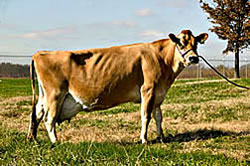 Here’s a technical story that I’m going to depend on the release writer from the Agricultural Research Service to explain in their words.
Here’s a technical story that I’m going to depend on the release writer from the Agricultural Research Service to explain in their words.
In ARS lab studies, a new two-in-one recombinant protein was developed, which kills several bacteria known to cause mastitis in dairy cows. Last year ARS reported success by a different research team in producing transgenic cows (including “GEM,” pictured) that were protected against a single major cause of mastitis, the bacterium Staphylococcus aureus.
An Agricultural Research Service (ARS)-led team has combined specific DNA segments from two different sources to produce a novel antimicrobial protein. The resulting “fusion” antimicrobial protein degrades the cell walls of several bacterial pathogens in a solution of whey extracted from cow’s milk.
Agriculturally, the technology provides a key step to developing dairy cows that have a natural, built-in defense against mastitis—a disease that costs U.S. dairy producers up to $2 billion annually.
In the realm of infectious disease, one way to reduce microbial resistance that results from widespread antibiotic use is to come up with new ways to fight pathogens. The findings from this experimental study were published in the April 2006 issue of Applied Environmental Microbiology.
While all milk contains several naturally occurring antimicrobial proteins, such as lysozyme and lactoferrin, the sale of milk containing the fusion protein would first require rigorous food safety testing and federal regulatory approval.
Bacteria have layers of macromolecules that provide strength and shape to their cell walls. The fusion antimicrobial protein, as a cell-wall-degrading enzyme, kills pathogens by decomposing this structural layer and causing the cell to break down.
